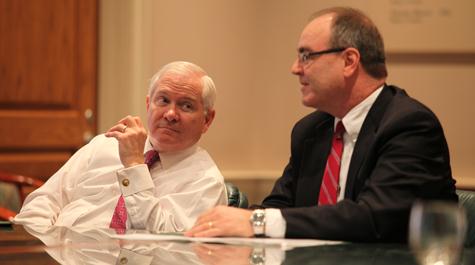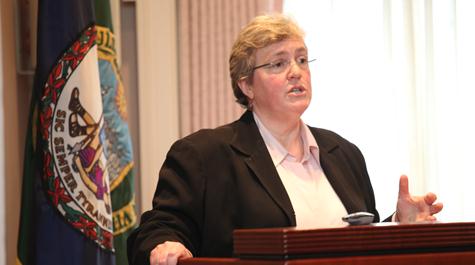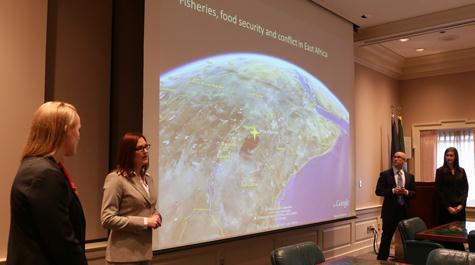Chancellor Gates participates in briefing on international research
William & Mary Chancellor Robert M. Gates ’65 L.H.D. ’98 was among a small group that received a briefing of four current globally focused research projects at the university.
Three of the four projects presented in the Feb. 6 briefing were student-faculty research projects affiliated with the university’s Institute for the Theory and Practice of International Relations (ITPIR). Sue Peterson, co-director of ITPIR, outlined the goals of the institute during the briefing.
“The institute was founded on the premise that international relations scholars can and should create knowledge that is useful for policymakers,” she said. “We provide a home for integrative interdisciplinary research programs that use social-science methods to address some of the most challenging international issues.”
The three ITPIR presentations covered the Project on Environment, Food and Conflict (ENFOCO); the Geospatial Analysis of Aid; and the Project on International Peace and Security (PIPS) within a Broader International Security Program.
Mike Tierney, co-director of ITPIR, explained that the three student-faculty projects presented are examples of internationally focused and interdisciplinary initiatives that involve researchers in the natural sciences and the social sciences who are doing “serious research to address real world problems.”
Students involved in the ITPIR research presented, along with their faculty mentors. The ENFOCO presentation outlined the group’s GIS-driven investigation of the relationship among fisheries, food security and social conflict in the communities surrounding Africa’s Lake Victoria. The Geospatial Analysis of Aid group focused on the use of GIS mapping to illustrate international aid as an agent of land cover change in a number of global locations. The PIPS presenters discussed the success of the program as a policy “think tank” for undergraduates and outlined a plan to build on the university’s current international security initiatives to develop a formal International Security Program.
The fourth presentation, not associated with ITPIR, was from the National Security Archive Project, which uses documents from former Latin American military regimes and from declassified U.S. government documents to study the history of Cold War-era repression and violence. The research from this project has been used in scholarly publications and in court cases to prosecute individuals accused of human rights violations.
Gates listened attentively to the introductions and the four presentations, taking notes and making the occasional comment. At the conclusion of the briefing, he asked a number of questions of the presenters and made suggestions on the research. The chancellor’s resume includes serving as both U.S. secretary of defense and director of central intelligence—in addition to being past president of Texas A&M University. He has the ultimate insider’s view on international matters and was able to give the researchers advice on how to increase the relevance of their projects. In most cases, the presentations struck a chord with the chancellor.
For instance, Gates responded to a presentation by members of the geospatial analysis of aid project. Stuart Hamilton of the university’s Center for Geospatial Analysis said that on one occasion he witnessed a crew funded by one U.S. private foundation planting trees on one side of an Ecuadorian estuary, while on the other side, another aid group was funding the bulldozing of trees.
“That kind of opened my eyes a little bit,” Hamilton said. Gates noted that such examples of counterproductive projects are all too common in the delivery of foreign aid.
“Your example of one group of aid people planting trees on one side of the river and another cutting them down on the other is totally characteristic of Afghanistan,” Gates said, “because you’ve got probably fifty countries engaged, countless NGOs, and nobody knows what anybody else is doing.”
The chancellor cited an Afghanistan aid project that built a road that ended abruptly at the Pakistan border, to the bemusement of the local population. “The Pashtuns don’t even recognize that border,” he said. “It’s Pashtuns on both sides of the border, and yet….”
Gates said that one of his hopes as secretary of defense—only partially realized—was to have a senior international person to coordinate the aid projects in Afghanistan. He suggested that the researchers expand their project to include a component that addresses coordination. He added that he had urged officials in the state department and other federal agencies to figure out how to tap into expertise of the researchers already working in the world’s trouble spots.
“A lot of universities have agriculture experts all over Iraq and Afghanistan and they’re accustomed to living in tough places and to being in dangerous places,” Gates said. “So the irony is that you have a lot of university faculty where aid workers and state department people wouldn’t go.”
Gates expressed interest in the involvement of students in the research projects. He asked in particular about the two students who worked with ENFOCO.
“I’d be interested to hear from the two students who were in Uganda about their on-the-ground experience,” Gates said, “just in terms of how long you were there, some of the challenges you faced day-to-day.”
Colleen Devin ’13 and Catherine Mahoney ’15 took turns relating their daily experiences collecting data. The locals were helpful for the most part, except at one beach which Mahoney said seemed to be under the control of a man she described as a “boss of the beach,” who was “intimidating to say the least.”
Speaking before the briefing, Tierney said he believed the presentations would be of particular interest to Chancellor Gates. William & Mary’s student-faculty research model was lauded by Steve Hanson, vice provost for international affairs and director of the Reves Center, who delivered introductory remarks before for the briefing.
“International relations is something, Chancellor Gates, that your own career has personified,” Hanson said. “We think that we’ve set up a model for international relations teaching and research which is unique in the world. Students are at the center of what we do—teaching through research.”
Hanson pointed out the numerous student-faculty collaborations that have resulted in the publication of books and articles in peer-reviewed journals, noting that William & Mary students are typically involved in all areas of research, from conceptualization through data collection and analysis.
“And this is something that you don’t find at many bigger research universities, nor at smaller liberal arts colleges less focused on research,” Hanson told Chancellor Gates.
In her overview of ITPIR, Peterson noted that the institute is home to seven interdisciplinary, student-faculty research projects, including AidData, which recently attracted $25 million in support from USAID to establish the AidData Center for Development Policy.
At the end of the briefing, Rector Jeffrey B. Trammell ’73 commented on the high esteem that the international relations efforts of William & Mary enjoys at the highest level of government and academia. He referred to the November presentation in the Ben Franklin Dining Room of the State Department in which the AidData award was announced. William & Mary student Alena Stern ’12 represented AidData and the university and made quite an impression.
“Mark Yudof, who is president of the University of California, leaned over to me and he said, ‘Jeff, how do you find these students?’” Trammel said. “I said, Mark, we’ve got about three thousand of them if you want to come down and meet some of them.”
Gates summed up the briefing by pointing out the potential market advantage of the William & Mary style of student-faculty research in a time of tight funding.
“There is a movement in this country about higher education that holds that teaching benefits students and research by faculty does not,” the chancellor said. Such a notion is not valid at William & Mary, he added, and noted that faculty and administrators should make sure that opinion leaders and the media are aware of it.
“The kind of thing you’ve described here is the kind of proof positive of how integrated teaching and research are in a great university,” he said. “What is going on in research on one day is in the classroom the next.”
Projects discussed at the session were:
The Project on Environment, Food, and Conflict
Faculty: Cullen Hendrix, Government/ENSP; Sarah Glaser, Biology and Marine Science at W&M and the Virginia Institute of Marine Science
Students: Colleen Devlin ’13, Catherine Mahoney ’15
Geospatial Analysis of Aid
Faculty: Stu Hamilton, Center for Geospatial Analysis; Mark Buntaine, Government/International Relations; Marco Millones, Center for Geospatial Analysis
Student: Ericka Wenrich ’14
The Project on International Peace and Security within a Broader International Security Program
Faculty: Amy Oakes, Government; Dennis Smith, Government
Student: Emily Pehrsson ’13National Security Archive Project
Faculty: Silvia Tandeciarz, Hispanic Studies; Betsy Konefal, History


















